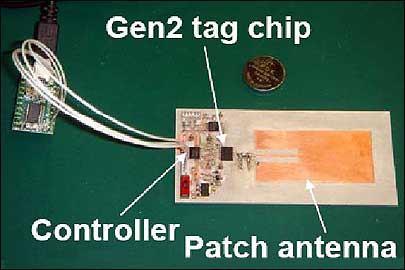In the retail supply chain, radio frequency identification has emerged as a tool well suited for retailers and manufacturers. But for consumers, the technology’s value is limited, according to a group of researchers at the Auto-ID Lab Japan. The researchers—led by Jin Mitsugi, an associate professor at the Graduate School of Media and Governance at Japan’s Keio University, which hosts the lab—have developed a prototype of a hybrid passive and active RFID tag that could make consumer electronics more user-friendly.
“In Japan,” Mitsugi says, “we buy product from a store and [get] a warranty that is printed on paper. It contains the start date for the warranty. But consumers [sometimes lose the paper warranty] and forget when or where it was bought.” Being able to save this information directly onto the onboard memory of a laptop or other consumer electronic device is one possible application for this tag, which Mitsugi has dubbed a recorder tag.
Mitsugi presented the group’s recorder tag prototypes at an October meeting of EPCglobal‘s Joint Action Group (JAG) in Bonn, Germany. EPCglobal is an RFID standards-setting organization run by GS1, and the JAG is an amalgam of EPCglobal members from all industry and technical action groups contributing to the development of Electronic Product Code (EPC) standards.
The prototype contains a passive EPC Gen 2 chip wired to a large patch tag, as well as to a second chip—a low-power microcontroller manufactured by Renesas and designed for general consumer electronic applications. This chip, Mitsugi says, is used to provide a means of exchanging data with the electronic device to which the recorder tag is attached. To communicate with the device in which it is embedded, the chip would employ a simple communication scheme instead of the EPC Gen 2 communication protocol, which uses anti-collision algorithms and other procedures to transmit and receive data. Such EPC Gen 2 procedures, he explains, “could be a burden to hosting electronics (such as consumer electronics).”
With the prototype, the recorder tag is connected to a laptop through a USB port. In a commercial version, the tag would be hardwired directly into the computer, or any other electronic device, as long as that machine had a display screen able to support human-readable text, a flashing LED or any means of communicating tag information to a consumer, without requiring the customer to purchase an RFID interrogator. What’s more, Mitsugi says, both the EPC chip and the secondary chip would be integrated into a single IC. This integrated chip would support the EPC Gen 2 tag air-interface protocol. The communication scheme between the chip and the device into which it is integrated would then need to be developed.
During the manufacturing of an electronic product, an EPC serial number would be encoded to the recorder tag’s chip, which would be utilized to track the device through the supply chain. Once the product is purchased, the tag could be used to record data related to a warranty or other information linked to that particular user. The information stored on the tag could then be read on the device itself, through its display screen, so consumers could access the data without needing to obtain an RFID reader. This would enable a consumer to easily determine when a laptop’s warranty is due to expire, or look up the terms of that warranty, without having to contact the manufacturer.
The tag data would also be accessible via an interrogator, thereby allowing a technician who receives a non-functioning laptop for repair to access information regarding that computer, even if it will not power up. Or, the manufacturer or recycler could access this data via an RFID reader in order to access the device’s component specifications, which could streamline the disassembly and recycling process at the end of the device’s life.
Additionally, the recorder tag could provide a means of collecting data related to safety. A temperature sensor, for instance, could be attached to a recorder tag, which would contain a log of a device’s internal temperature. Manufacturers could then correlate the temperature and usage data in order to better understand the underlying causes of fires or explosions due to overheated batteries.
Outside of retail supply chain applications such as these, Mitsugi says, officials within the aerospace industry have expressed interest in integrating the recorder tag into parts, in order to collect their usage and maintenance histories. The same type of application could be utilized for automobiles or trucks. With the addition of sensors inside the parts, the recorder tag could also track the conditions to which parts are exposed during their lifetimes. This would extend the usefulness of RFID tags, compared with those attached to a part’s housing and used only to store that part’s ID number, linked to maintenance and usage history stored in a database. Furthermore, it would eliminate the need to tag the parts after they are manufactured.
Mitsugi says he hopes, in 2009, to have a secondary prototype, sporting a IC that integrates the two separate chips in the current prototype, and that can hold up to 2 kilobits of data. Once this new model is ready, he intends to show it to members of EPCglobal, as well as other interested parties. At the October JAG meeting, he states, “there was interest, but they basically said, ‘Keep working on it.'”
According to Mitsugi, the price of a final version of a recorder tag has yet to be determined.


